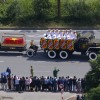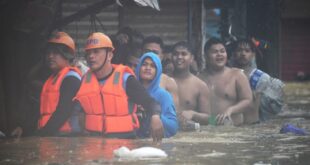Binh Chanh, Can Gio and Cu Chi districts all target to develop into cities within Ho Chi Minh City.
Party Chief of Binh Chanh District Tran Van Nam said the model of district-level administration is no longer suited to the speed of urbanization and socio-economic development of the district, and therefore it has set a target to develop into a city by 2025.
Binh Chanh lies at the gateway of HCMC and is the third largest district in the city after Can Gio and Cu Chi.
The district has now met the criterion to become a city: having both areas that focus on agriculture and rural development and areas that are urbanizing fast.
To realize the goal of becoming a city, Binh Chanh District needs to innovate its management method, focus on supporting businesses, and improve the capacity of officials and employees.
The locality will focus on solving problems that businesses and the people are facing, especially in the field of real estate.
For now, Binh Chanh is reviewing all criteria to become a city to determine its investment plan for the next four years.
The cost for construction investment, including traffic infrastructure projects, is now estimated at VND44 trillion ($1.9 billion).
In order to mobilize this resource, the district will need to adjust the appropriate planning and create a mechanism to attract private investment and exploit the agricultural land fund.
Meanwhile, Party Chief of Cu Chi District Nguyen Quyet Thang said the district will develop in the direction of an ecological urban area.
Once a city, Cu Chi will retain its farmland, said Thang.
This district has land resources combined with externally mobilized resources to develop towards a smart eco-friendly city that develops both industry and high-tech agriculture.
“Cu Chi must attract resources, improve its land value, form high-tech industrial parks, and attract businesses to produce clean agricultural products,” he said, adding that in future, the district will not encourage occupations that pose pollution threats and use too many workers.
Meanwhile, the coastal Can Gio District has been oriented to develop into an eco-tourism and eco-resort city.
The district is coordinating with other departments to develop the project, and collect ideas from scientists to complete and determine an investment roadmap.
“Can Gio will be a place for large and modern urban development, and at the same time ensure that its biosphere reserve will be left unaffected,” HCMC Vice Chairman Vo Van Hoan told a city meeting last March.
According to the HCMC Department of Home Affairs, the districts of Hoc Mon, Binh Chanh, Nha Be, Cu Chi and Can Gio are located at the gateway to the city, connecting the eastern and western provinces of Vietnam’s south.
In recent years, these localities have rapidly urbanized, with many infrastructure projects, and highways formed.
Therefore, developing them into cities is necessary.
Yet, Ngo Viet Nam Son, an architect with 30 years of experience in design consultancy and architectural planning, said “this is not an urgent matter and HCMC should not force it to happen.”
Accelerating urban development is not necessarily good for HCMC because agriculture involves not only rice production, but also cultivating ornamental plants and green vegetables to supply more than 10 million people in the city.
For now, in the inner-city area, each person has only 0.5 square meters of green space and when a series of districts are turned into cities, it will affect the environment.
Son went on the say that when districts become cities, it is not the people who benefit the most but real estate developers.
The move will only raise property prices and push the chance to afford a house of people farther, he said.
“Thu Duc has been a city for over a year now and since then prices of real estate projects have increased significantly but the economic benefits it brings about are not as expected.”
Le Hoang Chau, chairman of HCMC Real Estate Association, said setting up cities inside cities is necessary to ease the pressure on downtown areas and having the population spread equally.
The city has different criteria than the district and once a city, one locality can proactively decide its orientations, specific urbanization levels, promote land efficiency, improve people’s quality of life and urban appearance.
HCMC spreads over more than 2,000 square kilometers and is home to around 13 million people, including migrants.
It now has 21 districts and Thu Duc City, which was officially set up in December 2020 by combining three former districts of Thu Duc, 2 and 9.
- Reduce Hair Loss with PURA D’OR Gold Label Shampoo
- Castor Oil Has Made a “Huge” Difference With Hair and Brow Growth
- Excessive hair loss in men: Signs of illness that cannot be subjective
- Dịch Vụ SEO Website ở Los Angeles, CA: đưa trang web doanh nghiệp bạn lên top Google
- Nails Salon Sierra Madre
 VnExpress News The News Gateway of Vietnam
VnExpress News The News Gateway of Vietnam





